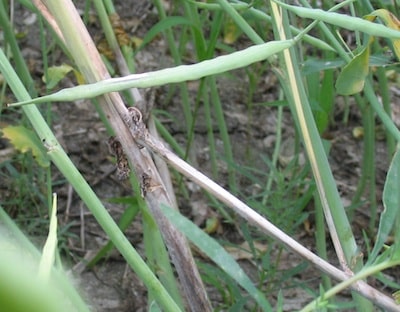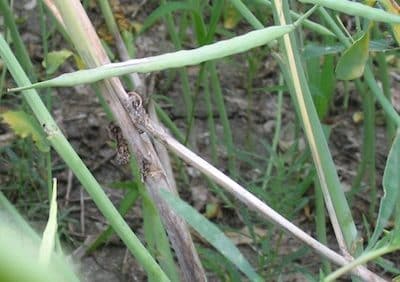
Moisture before and during and following flowering was the biggest factor driving up sclerotinia stem rot infection this year. Moisture as rain or high humidity or dew through the period from two weeks before flowering through early podding has increased the sclerotinia risk considerably, no matter the rotation history of the field — given that the stem rot pathogen is readily dispersed from adjacent fields. Most regions had these conditions this year.
Moderate temperatures and moisture as the crop comes into the rosette to bolting stages favours germination of sclerotia to produce apothecia. Moderate temperatures and moisture during flowering favours plant infection from petals infested with spores dispersed from the apothecia.
If conditions are dry with low humidity through that period, the risk will be lower. If conditions are excessively wet, to the point where apothecia have water droplets on them and spores are washed onto the soil surface rather than being released into the air, the risk may be lower.
Fungicide: Fields that were sprayed with fungicide in the 20% to 50% flower window can still have sclerotinia. Fungicides will reduce the incidence and severity of infection but will not eliminate sclerotinia completely, especially if conditions are favorable all through flowering. Spraying twice will help prolong the protection when the flowering period is extended, but even that will not completely eliminate the disease when pressure is high.
Rotation: Because environment is such a large factor in sclerotinia infection rates, and with so many acres of host crops (canola, peas, lentils, etc.), rotation on any one field does little to reduce the sclerotinia risk.
Hail: Hail can move the food source for the germinating sclerotinia spores — petals and stripped leaves — down into the canopy where it may increase the level of infection, but could also move those petals off the leaves onto the ground reducing infection. Hail at flowering can also extend the flowering period, which extends the susceptible period. The effect of hail will be highly variable, depending on the timing and severity and the prevalence of sclerotinia prior to the storm. But hail cannot cause sclerotinia. The moisture conditions and a sufficient supply of sclerotinia spores have to be there, and if yes, the field was at risk for stem rot whether it hailed or not. Also, wounds from hail do not create entry points for this disease that would not otherwise be there. There is no evidence that this pathogen will enter plants directly through a hail wound.
Planning for next year: For infested fields, think back to the risk profile in the field when you were making the fungicide decision. If you didn’t spray, what made you decide not to spray? If you did spray and sclerotinia infection rates are still high, at what stage did you spray? At what rate? What were the conditions (some fungicides lose efficacy if sprayed above 25 C)? Answers to these questions will help with the spray decision next year.

